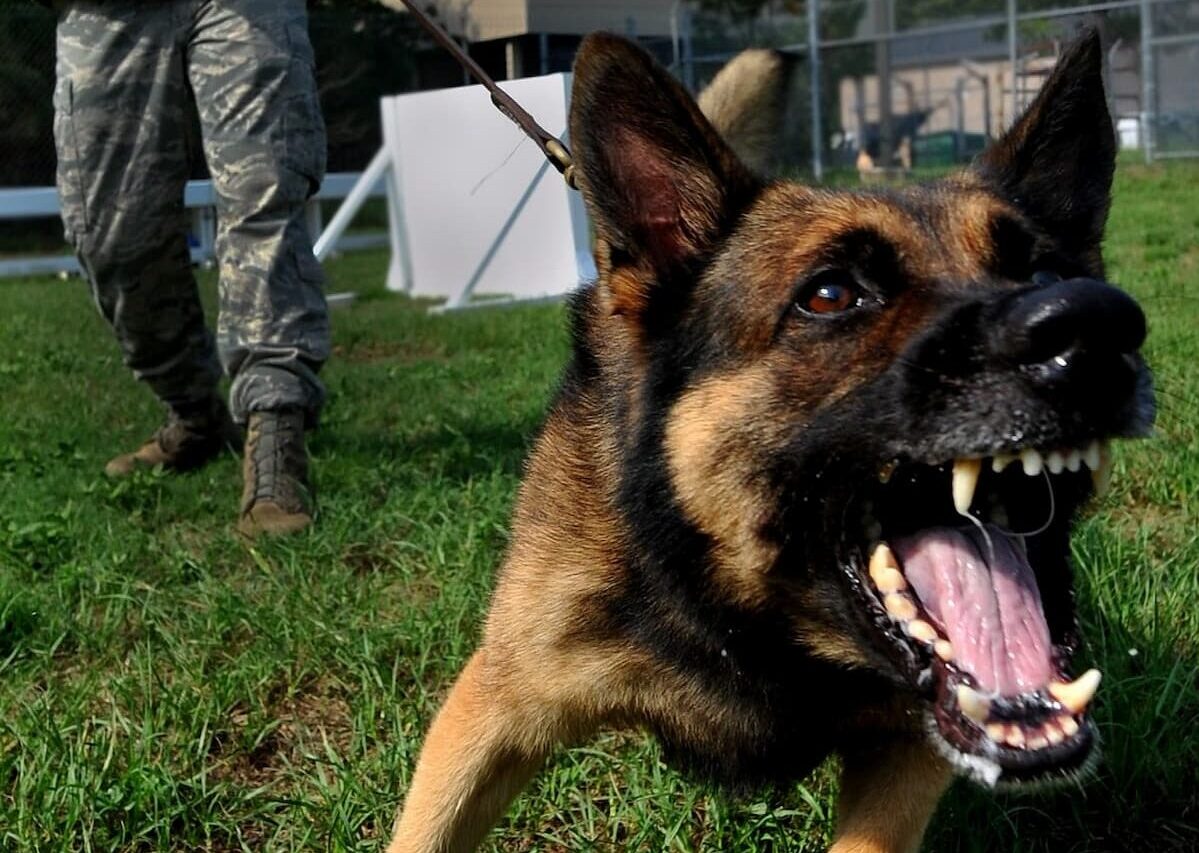Picture this: You’re settling down on your porch, enjoying a book and the warm sun on your face, when suddenly, a symphony of barks erupts next door.
Perplexed, you glance over to see your neighbor’s dog, nose pressed against the fence, engaged in a full-blown conversation with your beloved furry friend.
It’s a familiar sight, one that has intrigued pet owners for ages – why do dogs bark at each other through the fence?
Read on to have this question answered.
Why Do Dogs Bark at Each Other through the Fence?
Dogs are known for their vocal nature and often engage in barking to communicate with humans and other animals.
If you’ve ever wondered why dogs bark at each other through the fence, you’re not alone.
This behavior is commonly seen in our furry friends and can be attributed to a combination of instinct, territorial behavior, and social communication.
So, why exactly do dogs bark at each other through the fence?
Let’s dig deeper:
1. Territorial Instincts
One of the reasons dogs bark at each other through the fence is because they are protecting their territory.
Dogs have a strong sense of ownership over their environment, including their yard or home.
When they encounter another dog near their territory, they may perceive it as a potential threat and respond by barking.
This instinctual behavior serves as a warning to ward off intruders and defend their space.
Moreover, a fence can play a significant role in intensifying a dog’s territorial behavior.
Dogs view fences as a clear boundary between their territory and the outside world.
When another dog approaches this boundary, it’s only natural for our canine companions to react by barking, growling, or even lunging.
Their goal is to warn the perceived intruder and keep them at bay.
2. Social Communication
Barking also serves as a way for dogs to communicate with each other.
While humans may rely on verbal language, dogs use a variety of vocalizations, body language, and scent to convey messages.
When two dogs bark at each other through the fence, they are engaging in a form of communication.
This could be an expression of excitement, an invitation to play, or a warning to maintain distance.
Pay attention to the intensity, pitch, and duration of the barks as these factors can provide hints about their intentions.
3. Frustration and Attention Seeking
Sometimes, dogs bark at each other through the fence out of frustration or a desire for attention.
Dogs are naturally social creatures, and being separated by a fence can lead to feelings of confinement and isolation.
Barking in such situations may serve as an attempt to release pent-up energy or seek interaction with the other dog.
It’s important to understand that this behavior should be addressed appropriately to prevent excessive barking, anxiety, or aggression.
Tips for Dog Owners to Reducing Fence Barking
Now that we understand why dogs engage in fence barking, what can we do as responsible dog owners to minimize this unwanted behavior?
Here are some helpful tips:
Provide mental and physical stimulation for your dog: A tired dog is less likely to engage in excessive barking.
Regular exercise and interactive toys can help channel their energy in a positive way.
Block the view: Limit your dog’s visual access to the fence by using privacy screens or planting shrubs in front of it.
This can reduce their temptation to bark at passing dogs or neighbors.
Train your dog: Teaching your dog basic commands such as “quiet” or “leave it” can help redirect their attention and discourage fence barking.
Reward them with treats or praise when they respond appropriately.
By implementing these tips, you can create a calmer and more peaceful environment for both your dog and your neighbors.
Remember, it takes time and consistency to modify your dog’s behavior, so be patient and stay committed to their training.
Building Positive Introductions to Help Dogs Socialize and Manage Fence Aggression
It’s also important to address this fence aggression to ensure your dog’s well-being and to promote positive social interactions with other dogs.
Here are some tips to help your dog overcome its fence aggression.
One of the first steps in addressing fence aggression is to provide your dog with proper socialization from an early age.
Socializing your dog means exposing them to different situations, people, and other animals, allowing them to develop good manners and positive interaction skills.
By introducing your dog to various environments, such as dog parks or playdates with other friendly dogs, you can help reduce their fear or anxiety towards unfamiliar dogs.
This exposure will play a crucial role in minimizing their fence aggression and promoting positive introductions.
Another strategy to help your dog manage fence aggression is to create a positive association with the presence of other dogs.
You can do this by rewarding your dog with treats or praise when they remain calm and relaxed while another dog passes by the fence.
By consistently rewarding this positive behavior, your dog will start to associate the presence of other dogs with positive experiences, gradually reducing the intensity of their barking and fence aggression.
Providing distractions, such as toys or puzzles, can also redirect your dog’s attention away from the fence and towards something enjoyable, making the overall experience more positive.
Lastly, it’s important to set your dog up for success by creating physical barriers or boundaries that can help minimize direct exposure to other dogs.
For instance, you can install privacy screening or use visual barriers, such as plants or fences, to reduce your dog’s visual stimulation.
Additionally, providing designated play areas in your yard can give your dog a safe space to interact with others, preventing unnecessary confrontations at the fence.
Implementing these physical boundaries can help manage your dog’s fence aggression and create a calmer environment for them to socialize.
Remember, addressing fence aggression requires patience, consistency, and positive reinforcement.
By following these strategies and providing your dog with the necessary socialization and management techniques, you can help them build positive introductions with other dogs and create a harmonious neighborhood for everyone to enjoy.
So, the next time your furry friend starts barking at another dog through the fence, you’ll be equipped with the knowledge and tools to help them overcome this behavior and foster healthy social interactions.
FAQ
Q: Why do dogs bark when they see another dog on the other side of the fence?
A: Well, dogs have a complex communication system that involves barking, body language, and scent marking.
When they see another dog on the other side of the fence, their instinct kicks in, and they feel compelled to vocalize their presence.
Q: Does this mean dogs are being aggressive or unfriendly?
A: Not necessarily.
Barking at each other through the fence is often more about territorialism and establishing boundaries rather than aggression.
Dogs are naturally protective of their home environment, and when they see an intruder (another dog) near their perceived territory, they may feel the need to sound the alarm.
Q: But my dog is friendly and sociable, why would they still bark?
A: It’s important to remember that even the friendliest and most well-behaved dogs can exhibit this behavior.
It’s not always a sign of unfriendliness, but rather a form of communication.
Dogs use barking as a way to say, ”Hey, you’re on my turf, and I’ve got my eye on you!”
Q: Is there anything I can do to stop my dog from barking at other dogs through the fence?
A: Absolutely!
Here are a few tips that might help:
1. Socialization: Expose your dog to various situations and other canines from an early age.
This can help them become more relaxed and less reactive when encountering other dogs.
2. Distractions: Provide your dog with distractions, such as toys or treats, to divert their attention away from the perceived threat behind the fence.
3. Proper training: Teach your dog basic obedience commands like “quiet” or ”leave it” so you can redirect their behavior when they start barking excessively.
Q: Are there any potential downsides to dogs barking through the fence?
A: Excessive barking can sometimes escalate the situation and cause anxiety or stress for both dogs.
It may reinforce fear or aggression in either dog, which is why it’s essential to address this behavior if it becomes problematic.
Q: Should I let my dog interact with the dogs on the other side of the fence?
A: It depends on the situation.
Some dogs may benefit from controlled, supervised interactions, while for others, it may be best to keep them separated.
Assess your dog’s temperament and the other dog’s behavior before allowing any physical contact.
Q: Can dogs eventually learn to stop barking at each other through the fence?
A: With proper training, patience, and consistency, dogs can learn to be less reactive over time.
However, it’s essential to keep in mind that some dogs may never entirely stop barking in certain situations.
It’s a natural behavior for them, after all.
Q: Is there anything else I should know about dogs barking through the fence?
A: Remember that every dog is different, and their reasons for barking through the fence may vary.
It’s important to observe their body language, consult with a professional trainer if needed, and provide a safe and enriched environment to help curb excessive barking.
So, the next time you see your pup barking at the neighbor’s dog through the fence, you can now better understand their perspective and take steps to ensure a more peaceful interaction.
Happy barking, everyone!
Closing the Chapter
Dogs are incredibly social creatures, with an instinctual need to communicate and protect their territory.
From territorial disputes to pure excitement, barking through the fence allows our furry friends to establish boundaries and assert their presence.
It’s their way of saying, “Hey, this is my territory, and I won’t let anyone invade it!”
But let’s not forget the importance of the visual aspect in this theatrical display of canine communication.
With their tails wagging and ears perked up, dogs are not only barking but also using their body language to convey messages to their fence-bound friends.
Their entire posture becomes part of the conversation, providing additional insight into their intentions.
So, the next time you spot our four-legged companions engaging in their fence-side conversation, take a moment to observe.
Listen to the rhythm of their barks, decipher their body language, and appreciate the complexity of their canine social network.
While it may seem noisy and chaotic, this interaction is an integral part of their socialization and helps maintain harmony in their doggy world.
Just like humans chatting over a fence or across a sidewalk, dogs are simply engaging in their version of catching up and keeping in touch.














